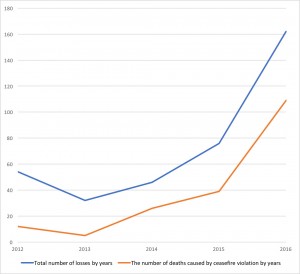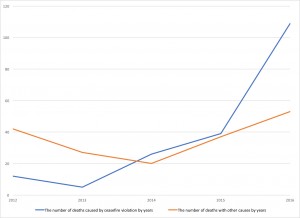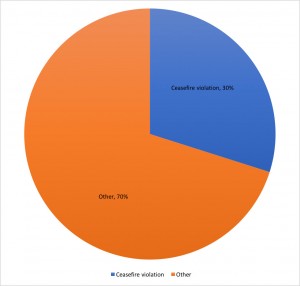
Illustration “Nation-Army”, © 2017 Peace Dialogue NGO
On October 27, 2017, the RA National Assembly adopted a draft of the “Law of the Republic of Armenia on Military Service and the Status of Military Serviceman.” According to that draft of the law, each Armenian male citizen of 18 years of age will be drafted for military service. Through the bill, the authors seek to ensure the effectiveness of the Armenian Armed Forces in peace and in war both; to increase the citizens’ trust in the compulsory military service and in the reserve forces training; to encourage citizens to demonstrate their will to pass mandatory and contractual military service; and to promote the full implementation of the “Nation-army” doctrine.
In the context of this ideology, a lot of discussions have been held over the military-political events in the region and the security threats that Armenia faces today. “The military-political events taking place today in the region and the military threats faced by the two Armenian states allow us to foresee that Armenia’s security environment and the challenges the armed forces face may not undergo significant changes in the near future.”- said Minister of Defense Vigen Sargsyan during the discussion of the draft law in the government. Many in the experts and politicians think that with the current geopolitical background the concept of “Nation-army” will contribute to the increase of the combat readiness of the armed forces.
The growing tension in the line of contact between the Armenian and Azerbaijani armed forces over the recent years is one of the main threats to the Armenia’s security. When referring to the total number of losses of the Armenian and NK side since 1994, it should be noted that no official information has been published in this regard. According to the data provided by the civil society organizations and human rights defenders, the total number of losses is up to 3000 lives. According to ANI Armenian Research Center the total number of combat and non-combat losses is 3.500 since the ceasefire signed in May 1994.
The Peace Dialogue NGO’s website www.safesoldiers.am (data on the fatalities recorded in the Armenian and NK army since the trilateral agreement on ceasefire signed in 1994), shows that during the last three years, the number of deaths of soldiers, due to the constant tension in the line of contact and the consequent ceasefire violations, has increased.
According to the organization’s data, 12 deaths were registered as a result of ceasefire violations in 2012, which makes up the 22% of the total number (54) of death cases registered the same year. In 2013, 5 death cases were recorded as a result of ceasefire violation (16% of the total 32 deaths). In 2014 the number of death cases as a result of ceasefire regime violation makes up 57% of the total number of fatalities: total number of fatalities was 46 and 26 of them were the result of ceasefire regime violations. In 2015, 39 (51%) out of 76 fatalities and in 2016 the ceasefire regime violation death cases were 109 (67%) out of 162 fatalities (including the four-day war in April).
It should be noted that the calculations are based on the data on www.safesoldiers.am website and the data may not be compatible with the actual numbers of casualties of those years or the numbers revealed by other organizations. According to the data provided by Helsinki Citizens’ Assembly Vanadzor Office, for example, the number of victims in 2016 was 175, however according to the sources available for Peace Dialogue NGO, including the official sources, no information in other reliable source was found related to the 13 losses mentioned by HCA Vanadzor.
Thus, based on the results of the monitoring conducted by Peace Dialogue NGO, the following picture revealed:
Year |
Total Losses* |
Ceasefire Violations ** |
% |
| 2012 | 54 | 12 | 22% |
| 2013 | 32 | 5 | 16% |
| 2014 | 46 | 26 | 26% |
| 2015 | 76 | 39 | 51% |
| 2016 | 162 | 109 | 67% |
* Total number of losses by years
** The number of deaths caused by ceasefire violation by years
 (INFOGRAPHIC 1.) Comparison of the total number of deaths in the RA Armed Forces and the NK Defense Army and the number of casualties as a result of ceasefire violations during the period 2012-2016.
(INFOGRAPHIC 1.) Comparison of the total number of deaths in the RA Armed Forces and the NK Defense Army and the number of casualties as a result of ceasefire violations during the period 2012-2016.
It is clear from the picture that after 2013, the apparent increase in the number of deaths as a result of ceasefire violation has been registered and the total number of victims has increased as well.
Studying the statistics of the deaths of soldiers killed in other incidents during the same years, it turns out that the number of ceasefire violation deaths has increased almost simultaneously with other fatalities. Moreover, if we take into consideration the data of deaths provided by the HCA Vanadzor in 2016, the number of deaths that were the result of other reasons will be higher.
Year |
Ceasefire Violations * |
Other Causes** |
| 2012 | 12 | 42 |
| 2013 | 5 | 27 |
| 2014 | 26 | 20 |
| 2015 | 39 | 37 |
| 2016 | 109 | 53 |
* The number of deaths caused by ceasefire violation by years
** The number of deaths with other causes by years
 (INFOGRAPHIC 2.) The correlation between the numbers of deaths caused by ceasefire violation and deaths with other causes during the period 2012-2016.
(INFOGRAPHIC 2.) The correlation between the numbers of deaths caused by ceasefire violation and deaths with other causes during the period 2012-2016.
The number of fatalities in the armed forces posted on www.safesoldiers.am that have been recorded since the signing of the ceasefire is 1020 as of November 3, 2017. The information about 1020 fatalities that became available to the organization from different sources, such information received from various official and non-official sources, was compiled in the organization’s database. Only 305 cases out of 1020 fatalities are the result of ceasefire regime violation. The remaining 715 deaths of soldiers have different causes: 221 murder cases (22%), 190 fatal incidents (19%), 30 violations of safety rules (4%),106 suicides (10%), 89 cases of health issues (9%), 11 cases of official negligence (1%), and 59 cases (6%) the causes of which are yet unknown.
Moreover, it should be noted that before the four-day war in 2016, only the number of murder cases available on the website were more than the number of deaths that were the result of ceasefire regime violation.
Based on the above-mentioned, only 30% of the 1020 losses recorded in the Armenian Armed Forces since 1994 was the result of a ceasefire violation. However, it should be noted that according to Peace Dialogue expert criminologist Ruben Martirosyan in the early 2000s many suicides and murder cases in the armed forces were presented by the officials as ceasefire regime violations of the Azerbaijani forces. Other human rights organizations in Armenia have also referred to this issue.
In most of such cases, in the absence of evidence-proof indicators, the organization has no choice but post the data from the official government sources.
There are good reasons to claim that such practice is being implemented so far as continuous monitoring of the organization has shown cases when the cause of soldiers’ deaths has been changed several times by the relevant authorities.
 (INFOGRAPHIC 3.) Comparison of causes of 1020 victims registered in www.safesoldiers.am after 1994.
(INFOGRAPHIC 3.) Comparison of causes of 1020 victims registered in www.safesoldiers.am after 1994.
Nevertheless, putting aside the occurrences when the deaths of the killed soldiers were presented as results of the ceasefire violation, 70% of the 1020 cases collected on the website are not connected with the violation of the ceasefire, instead they are the result of unresolved issues, unhealthy atmosphere in the army, and the non-statutory relationships.
Therefore, the security issues facing the Republic of Armenia are conditioned not only by external but also by internal factors: the geopolitical challenges have little to do with, for example, murders and suicides that are the result of an atmosphere of impunity in the military units, as well as the accidents caused by negligence or deaths of soldiers that were initially conscripted with health issues. In other words, it can be stated that the majority of losses are a direct consequence of the corruption in the relevant departments, the lack of proper organization of military service by the General Staff, the absence of efficient policy on military service organization by the Defense Ministry and so on.
Thus, the proposed draft law raises a number of questions:
- Why is the concept of “Nation-Army” proposed by the Defense Minister Vigen Sargsyan focused solely on the security issues caused by the actions of the external enemy and there is no reference made to the internal problems whereas more young lives will be lost because of the latter (at least so far).
- Is the “Nation-Army” concept able to offer tools that will prevent these human losses that are not conditioned by external factors?
- Is it possible to artificially raise citizens’ trust in compulsory military service, while serious causes for distrust are more than obvious?
- Will the army’s fighting capacity increase only by injecting patriotism in citizens and drafting them into army by force at the same time making no effort to ensure their dignified and safe military service?



